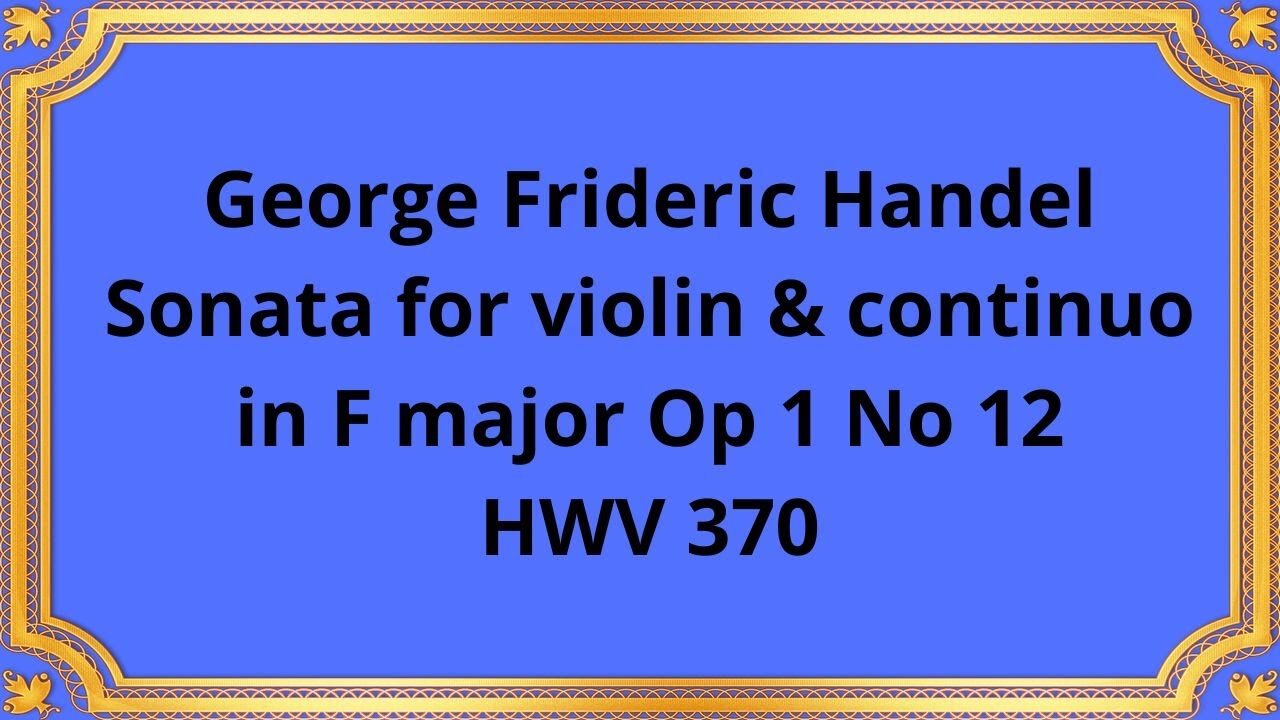Premium Only Content

George Frideric Handel Sonata for violin & continuo in F major Op 1 No 12 HWV 370
#GeorgeFridericHandel #Sonata #Violin #Continuo #FMajor #Opus1No12 #HWV370 #ClassicalMusic #MusicalComposition
Stefan Frenkel (violin)
Sterling Hunkins (’cello)
Ernst Victor Wolff (harpsichord)
George Frideric Handel's Sonata for Violin & Continuo in F Major Op. 1 No. 12 HWV 370 is a remarkable musical composition that showcases the composer's mastery of the Baroque style. Composed in the early 18th century, this sonata exemplifies Handel's ability to create captivating melodies, intricate harmonies, and virtuosic passages for the violin.
George Frideric Handel composed the Sonata for Violin & Continuo in F Major Op. 1 No. 12 HWV 370 during his time in Rome, Italy, around 1707-1709. Handel, a German-born composer, was renowned for his contributions to Baroque music and his ability to compose in a variety of genres. This sonata is part of a collection of twelve violin sonatas, known as "Sonates pour un traversière, un violon ou hautbois con basso continuo," which demonstrates Handel's mastery of the violin and his understanding of the harmonic possibilities of the continuo accompaniment.
Movement 1: Adagio
- The first movement of the sonata begins with a slow and expressive Adagio section.
- Handel establishes a poignant and lyrical melody, allowing the violin to sing over the continuo accompaniment.
- The movement showcases Handel's ability to create emotional depth and evoke a sense of introspection.
Movement 2: Allegro
- The second movement is an energetic Allegro, characterized by its lively and rhythmic nature.
- Handel presents a lively and spirited theme, which the violin explores through virtuosic runs, trills, and intricate passages.
- The movement displays Handel's skill in crafting engaging and thrilling music, designed to captivate the audience.
Movement 3: Largo
- The third movement offers a contrasting mood, with a slow and lyrical Largo section.
- Handel presents a tender and expressive melody, allowing the violin to showcase its expressive capabilities.
- The movement highlights Handel's ability to create emotional depth and elicit a sense of beauty and introspection.
Movement 4: Allegro
- The final movement is a lively Allegro, filled with energy and virtuosic passages.
- Handel's composition features rapid scales, arpeggios, and intricate ornamentation for the violin, demonstrating the technical prowess required for performance.
- The movement concludes the sonata with a spirited and exhilarating finale.
Handel's Sonata for Violin & Continuo in F Major Op. 1 No. 12 HWV 370 delivers a range of emotions and a display of virtuosity. From the introspective and expressive moments to the lively and spirited passages, the sonata evokes a sense of elegance, joy, and technical brilliance. Handel's skillful manipulation of dynamics, ornamentation, and melodic development allows for an engaging and emotionally rich performance, leaving the audience mesmerized.
Handel's Sonata for Violin & Continuo in F Major Op. 1 No. 12 HWV 370 remains an important work in the violin repertoire. Its beauty, technical demands, and expressive qualities have solidified its place as a staple in the Baroque era and beyond. The sonata's enduring popularity speaks to its timeless appeal and the lasting impact of Handel's compositional genius.
Conclusion:
George Frideric Handel's Sonata for Violin & Continuo in F Major Op. 1 No. 12 HWV 370 stands as a testament to the composer's exceptional talent and his mastery of the Baroque style. Through its captivating melodies, intricate harmonies, and virtuosic passages, the sonata takes listeners on a journey of elegance, beauty, and technical brilliance. Its continued presence in performances and recordings confirms its enduring significance in the realm of classical music, solidifying Handel's reputation as one of the greatest composers of the Baroque era.
You have the opportunity to support the channel:
https://destream.net/live/RadSiarAl/donate
https://www.buymeacoffee.com/6355radsiaral
-
 1:09:07
1:09:07
Donald Trump Jr.
6 hours agoBreaking News on Latest Cabinet Picks, Plus Behind the Scenes at SpaceX & Darren Beattie Joins | TRIGGERED Ep.193
111K267 -
 LIVE
LIVE
Roseanne Barr
2 hours agoGod Won, F*ck You | The Roseanne Barr Podcast #75
4,661 watching -
 LIVE
LIVE
Slightly Offensive
3 hours agoDEEP STATE WINS?! Matt Gaetz OUSTED as AG & Russia ESCALATES War | Guest: The Lectern Guy
720 watching -
 41:37
41:37
Kimberly Guilfoyle
4 hours agoPresident Trump Making all the Right Moves,Live with Border Union Chief Paul Perez & Lawyer Steve Baric | Ep. 176
80.6K18 -
 LIVE
LIVE
The StoneZONE with Roger Stone
3 hours agoWhy Democrats Hold Poor Children Hostage in Failing Schools | The StoneZONE w/ Roger Stone
674 watching -
 LIVE
LIVE
Tundra Gaming Live
3 hours agoThe Worlds Okayest War Thunder Stream//Air Force Vet Flys Jets
116 watching -
 2:00:54
2:00:54
Redacted News
5 hours agoBREAKING! Putin just SHOCKED the world, launches nuclear capable warheads "NATO can't stop it"
142K265 -
 55:37
55:37
Candace Show Podcast
5 hours agoMatt Gaetz Out, Jussie Smollett Walks Free! | Candace Ep 108
100K250 -
 DVR
DVR
LFA TV
22 hours agoTrump Has Learned His Lesson | Trumpet Daily 11.21.24 7PM EST
12.2K4 -
 DVR
DVR
theDaily302
11 hours agoThe Daily 302-Special Border Invasion Shutdown Show
7.84K